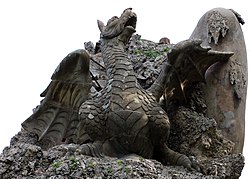Description
The colossus is about 11 metres (36 ft) high [1] and is meant as a personification of the Apennine Mountains. [3] [4] It was the water source for the Pratolino, [5] its fountains and secret water plays. [6] The colossus has the appearance of an elderly man crouched at the shore of a lake [7] and is surrounded by other sculptures depicting mythological themes from Ovid's Metamorphoses including Pegasus, Parnassus or Jupiter. [8] It is presumed that Giambologna was inspired by the description of a mountain-like Atlas in Ovid's Metamorphoses, when he designed the figure of Apennine. [8] Other sources cite the Atlas as described in the Aeneid of the Roman poet Virgil as an inspiration. [9] With his left hand in front of him, the Apennine seems to squeeze the head of a sea monster [7] through whose open mouth water emanates into the pond ahead of the statue. [10] The stone colossus is depicted naked, with stalactites in the thick beard [10] and long hair to show the metamorphosis of man and mountain, blending his body with the surrounding nature, populated by aquatic vegetation. [11] The statue is described to originally have been emerging from its environment [12] like being alive. The giant was able to sweat and weep over a network of water pipes. [5] In the winter season, icicles would cover his body. [5] The work was made of stone and plaster and appearing to be partially covered with moss and lichens. [11]
Within the giant exist a series of chambers and caves on three levels. [5] In the ground floor of the colossus exists a cave [13] containing an octagonal fountain dedicated to the Greek goddess Thetys. [14] The Italian painter Jacopo Ligozzi adorned the Grotto de Thetys [15] with frescos of villages from the Mediterranean coast of Tuscany in 1586. [16] In other chambers mining scenes based on the book De re metallica by the mineralogist Georgius Agricola were to be seen. [17] In the giant's upper floor is a chamber big enough for a small orchestra and in the head a small chamber holds a fireplace out of which the smoke would escape through his nostrils. [10] The chamber in the head had slits in the ears and the eyes. [7] Francesco I de Medici, Grand Duke of Tuscany, enjoyed fishing while sitting in the head chamber, throwing the fishing line through one of the eye slits. [5] At night the chamber was illuminated with torches, following which the eyes appeared to glow in the dark. [5] Initially, the back of the Colossus was protected by a structure resembling a cave, as seen on an etching by Stefano della Bella. [18] [14] As Giambologna was an admirer of the Italian sculptor Michelangelo the cave-like structure was also compared with Michelangelo's style of the non-finito. [4] On top of it, there was a terrace. [5] The cave-resembling structure was demolished around 1690 by the sculptor Giovan Battista Foggini, who also built a statue of a dragon [19] to adorn the back of the colossus. [5] The dragon was described to have been a fountain, but it is assumed the dragon's belly was transformed into a fireplace while the dragon's neck and head had the function of its chimney. [20] In 1876, the Italian sculptor Rinaldo Barbetti renovated the statue. [21]
Location and ownership
The Pratolino is located about 10 kilometres (6.2 mi) north of Florence at the foot of the Apennine mountain range. [22] In it, there is a rectangular square called the Prato del Appennino, situated in front of the colossus. [14]
After Francesco de' Medici's death in 1587 and that of his wife Bianca Capello the next day, [23] the villa and its surroundings fell into decay. [11] The Villa di Pratolino was demolished in 1822 [11] and in 1872, the heirs of Leopold II, Grand Duke of Tuscany, sold the estate [12] to the Demidoff family who built their own villa on it. [7] In 1981, the Villa Demidoff was purchased by the Province of Florence [24] and today the park and its giant are accessible to the public. [12]
This page is based on this
Wikipedia article Text is available under the
CC BY-SA 4.0 license; additional terms may apply.
Images, videos and audio are available under their respective licenses.






